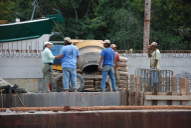
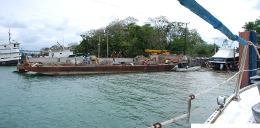
Dona and I were hoping to do some sailing and overland excursions, but before we could do much sailing Malakii needed to have some work done. So I flew down to Guatemala in late February, took the bus from Guatemala City to Fronteras a.k.a. Rio Dulce because it is the town on the river of that name. Normally I get to the Rio in time to catch a boat down the river to where Malakii is moored, but we spent several hours on the bus stopped in a construction traffic jam and didn't arrive until late. The guys on the collectivo launches said they'd take me down the river for 450q, about 5 times normal, as they had no other customers. I decided I'd rather not and spent the night at Tortugal Marina for 75q. I had a nice dinner and got a good night's sleep, then caught a collectivo launch down the river to my friend Jennifer Lindeen's place on Bahia de Buena Vista on the Golfete, known to most people, gringos and Guatemalans, as "Gringo Bay."
All things considered, Malakii was in pretty good shape. I spent a day or two putting her systems back together and generally cleaning up.
One big problem I discovered which I couldn't solve was with my outboard. It was a bear to start, and didn't run worth a darn. I took it apart and cleaned everything, but it still didn't work well. I asked Jennifer who she used for an outboard mechanic and she said Julio, the guardian on one of her neighbor's places. So I went over there and he took the carbureator off and stripped it and cleaned it up and when all was said and done... it didn't run any better. Grrr...
But my big job was to repaint the bottom. Malakii hadn't been out of the water in several years, and was overdue for new bottom paint. And as long as I was doing that, I decided to repaint the topsides too. She has always been unbearably hot, and after a number of experiments and talking to "those in the know," I was convinced a lot of the problem was her dark blue topside paint.
So I packed up and sailed her up to Astillero Magdalena, better known as Abel's Boatyard. I found Abel having his morning coffee and asked him if he would have room soon on one of his three marine railways to haul Malakii and paint her. Abel has handed most of the reins of the business over to his son, Juan, so he called Juan and I asked him. They would have room for us in two days. I anchored west of the shipyard, off the Castillo, and spent the rest of the day doing small jobs. It was unbearably hot and still, so I slept half the night up on the foredeck with a mosquito net hung from a halyard. I busied myself the next two days doing odd jobs and general maintenance, and pfutzing with the outboard some more. I replaced my main house battery. While reading in the evening I came upon two great sayings that seemed to resonate with me:
"Not all those who wander are lost."
J.R.R. Tolkein
"It is not good to dwell on dreams
And forget to live."
J.K. Rowling
When I think about those, it helps me to get off my butt and go do something adventurous.
When our day came, there was still a large cat on the railway ahead of me, and they first had to move it further up. It turns out it was the weird cat with asymmetrical pontoons from the Cay just north of Long Cay on Glovers.
While I was waiting I enjoyed watching a crew pour concrete on the travel lift under construction. Abel's has always been limited in the number of boats they can work on at a time because they have to haul them out on the railway, and the boats stay on the rail cars the whole time. The new travel lift will allow them to haul boats out of the water, then carry them to a place on short where they can be "unloaded" and blocked up, to be worked on without tieing up the haulout mechanism. Abel told me he had to get the cement from Guatemala City, as the local stuff wasn't of sufficient quality. It's always interesting to see what can be accomplished by determined people; in the United States nobody would even attempt hand mixing concrete for a project like this. And especially in a mixer that large!
 |
 |
| Concrete Crew | New Travel Lift under Construction |
Finally things were ready and Abel lowered the car into the lake. I brought Malakii into line with the upright supports and killed the engine. The yard hands tied our bow and stern to the uprights so we woulding tip over as we were hauled out of the water, and then the hard part began. Malakii has a fin keel, so when she is out of the water resting on it it's like resting on a single point. She would tend to tip forward and bury her bow in the dirt, so they need to block up the bow. On a conventional long keeled boat, the boat rests comfortably on the long line of the keel. It took the guys over an hour to build a stack of cross-hatched Santa Maria beams for the bow to rest on. Santa Maria is a really dense wood, so dense that it doesn't float. Or at least these well-used beams didn't. It took one or two big guys to haul the timbers down to the water, and then they had to muscle them into place underwater under the bow.
 |
 |
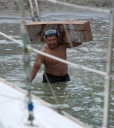 |
| Looking Up
the Railway |
Worker with
Santa Maria Timber |
Marvin with
Santa Maria Timber |
Once the crew had the bow properly supported, Abel started up the winch and we got a train ride up onto dry land. In the first photo below, you can see him in the little shed to the left and behind the catamaran which is on the railway ahead of Malakii.
The yard crew was great. I'm not the best at personal interactions and getting acquainted, especially in a foreign language. I tend to forget names as soon as I am introduced, and then it is embarassing to have to ask again and again and again. So one of the guy's names I never did get. Marvin was the head of the crew working on Malakii, and Leslie was next. Leslie was more on the ball than most everyone else, and both he and Marvin were great to work with. One other guy, who did the spray painting of the topsides, also helped with the blocking and is not in the photo. I think he was the overall main guy of all the workmen. He seemed to be pretty knowledgeable, but quiet and kind of aloof and harder to talk to.
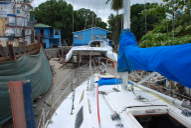 |
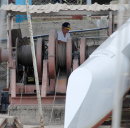 |
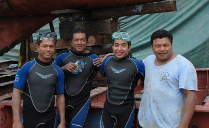 |
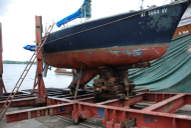 |
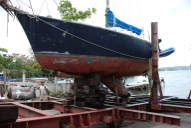 |
| Malakii going up the Railway | Abel Operating the Railway | Yard Crew: Leslie, Eli, Chepe, Marvin | Before repainting | Before repainting |
I continued living on Malakii while in the yard. It was kind of like living in a tree house, up above the rest of the world. It was fun to watch the fishermen return in the morning and mend their nets, and the women come down to the water to wash.
 |
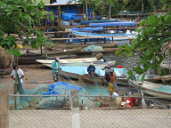 |
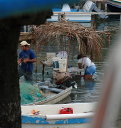 |
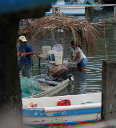 |
| Local Fishermen Mending Nets | Mending Nets
|
Wash Day |
After Malakii was up and out of the water, the guys washed her down. After washdown, we started cleaning off the hull so it could be repainted. There were huge colonies of barnacles on the keel, on the prop shaft and prop, and on the rudder; and it took a lot of effort to get them scraped off. We also found some blisters in the hull, which we cut out, drained, and dried so they could be patched. This was the first time we had found any blisters in the hull. I don't know if it was a result of the long time between repainting the hull, or whether age is finally starting to catch up with her.
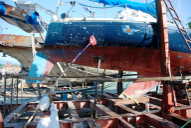 |
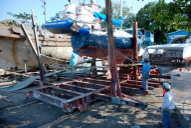 |
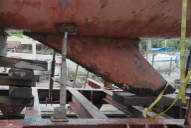 |
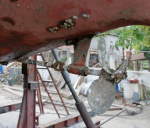 |
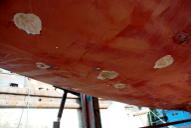 |
| Washing Down | Hosing Off | Barnacles | Barnacles on Propeller | Blisters cut out |
We repaired the rudder and patched a crack at the point where the keel joins the hull. I don't know whether that one will hold or not; it seems like an inherent weak point which will flex under any conditions and probably can't easily be kept closed.
 |
 |
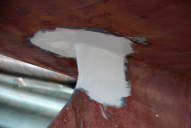 |
 |
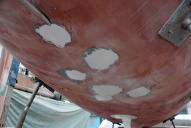 |
| Blisters Repaired in Rudder | Blisters Repaired in Rudder | Keel to Hull Joint Patch | Keel to Hull Joint Patch | Blister Repairs |
I kept pfutzing around with the dinghy motor, trying to figure out why it didn't have any power. It took me forever to go the two miles to town and back to get some groceries and read e-mail. I was going to have a heck of a time ferrying Dona and her backpack from Fronteras back two miles to the boat when I picked her up in a couple of days if I didn't get it fixed. I finally got smart and disconnected first one spark plug, and then the other. It was obvious that only one cylinder was firing. I switched plugs and what ignition wires I could, and eleminated them. Finally, after a lot of poking around and trying various things, I discovered that one of the ignition wires that is part of a permanent harness from the magnets around the rotor was rusted and broken. In order to fix it, I was going to have to obtain the whole assembly, and that wasn't going to happen any time soon. I found some stranded wire in my spare wire cache, scraped everything as clean as I could, then shoved it up the old wire as far as I could and tried to solder it, to no avail. I finally crimped it to the old wire as best I could. When I went to run the motor, it fired right up and ran ok. Yippie! A motor at last, for a while, anyway!
To offset my jubilation at figuring out what was wrong with the outboard, I had a night of jungle drums (loud Guatemalan music) and the local preacher stirring up the populace. Local color, or whatever else you want to call it...
While all that was going on, we were sanding and fairing the topsides. I finally had to decide on an exact color of paint, and chose a sandy color -- light enough to stay cool, but not a glaring ho-hum sailboat white.
We had to put off final sanding and fairing for a day because the wind came up and the guys didn't want to work behind the rail carriage posts with the wind, as the boat is balanced only on the jackstands when they go to work behind the posts. I was bummed, becuase the next day was Sunday, and they don't work on Sundays.
Surprise! The guys showed up to work on Sunday. They must have some time constraints and another boat they want to work on, so they want to get us finished and on our way. We taped up paper around the lifelines to keep overspray off, taped the boot stripe line, and then the yard paint expert whose name I don't know started in. He put two coats of an epoxy primer on. I was floored that he didn't wear a mask.
Monday morning we reputtied and wet-sanded the primed topsides, then started prepping for painting the final coats at 13:00. At 13:50 I left to go meet Dona at the bus in Fronteras. By then they had two coats on and were starting the third. I just hoped nothing happened that they needed an answer from me for...
I met Dona at the bus, more or less. The bus wasn't there when I got there, so I went to run some errands and in the meantime it came in. We went to Brunos and had a watermelon liquado, then piled into the dinghy and wallowed back to the shipyard. When we got there at 16:00, a spiffy new sandtone Malakii greeted us. Wow! What a difference a good paint job makes. We had to wait a few hours before boarding her, but when we did, she was much cooler than before. Yippie!
The next day the guys finished with the stuff below the waterline and put on two new coats of bottom paint. I was going to paint the bottom red, as it shows up better, but they were out of red so we did blue. I still haven't gotten around to figuring out where to put the boot stripe, so I left it off. Maybe next time.
 |
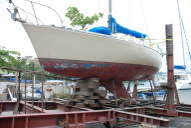 |
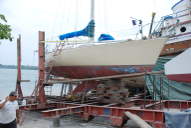 |
| New Topsides | ||
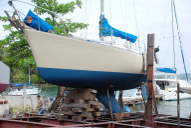 |
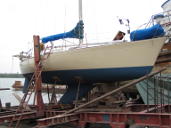 |
 |
| Malakii after complete Repaint
|
|
While I was helping the guys with the bottom, Dona did a little sight-seeing, wandering around the peninsula on which the boat yard is located.
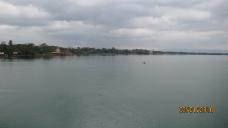 |
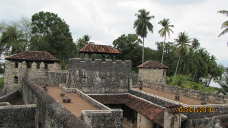 |
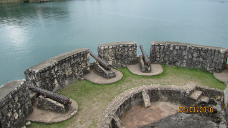 |
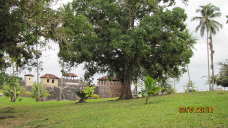 |
| Rio Dulce
|
Castillo de San Filipe
|
Castillo de San Filipe
|
Castillo de San Filipe
|
 |
 |
 |
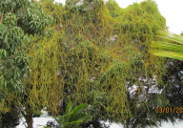 |
| Tree Flora
|
Tree Flora
|
Tree Flora
|
Tree Berries
|
 |
 |
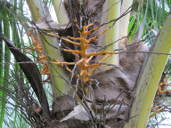 |
| Tree Blossoms
|
Oranges, maybe
|
Weird growth
|
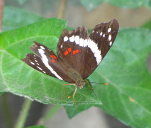 |
 |
| Butterfly
|
Locals
|
We splashed the next morning, and Dona took the helm as we sailed down to Fronteras, where we anchored and went ashore. I got some "Rotullos" (decals) made by a guy in a little shop with a computer guided cutting machine, so we could put Malakii's registration numbers and name back on. We picked up some burger and a few other items, then weighed the anchor at 14:00. With Dona at the helm and a stiff breeze blowing up the river, we headed down. We entered the Golfete at 15:30 and tucked in a reef, then beat on down to Gringo Bay. It was a fun ride, and as we were surging along, Dona keeping us on course and the sails filled, I had to check in, "Are we having any fun yet?" She gave me a big smile, so I guess we're ok for a while. The wind calmed down to almost nothing as we were heading into the bay, and we were able to sail easily up onto Malakii's mooring off Jennifer's by 17:30.
We had a yummy spaghetti dinner and a good quiet night's sleep. The next day we did wash and, put the numbers and name back on. So we were ready to do some sailing, but we weren't going to. Our schedule was too tight -- We had reservations at Pico Bonito on the 9th of March for my birthday, and I didn't want to chance missing that because of unfavorable winds, no wind, or bad weather. So the next morning we closed up Malakii and got a ride from Chico back up to Fronteras, and headed overland to Honduras.